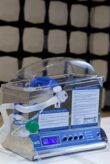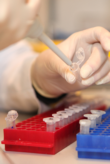PTB’s droplet digital PCR has what it takes to become a reference method to monitor the quality of medical analytical laboratories.
Scientists of the Berlin Institute of the Physikalisch-Technische Bundesanstalt (PTB) have adapted the innovative method of droplet digital PCR to detect SARS-CoV-2 and have applied it successfully within the scope of an international comparison measurement (a round robin test) in an external quality assurance scheme (EQAS). This comparison was organized by INSTAND e. V. (Gesellschaft zur Förderung der Qualitätssicherung medizinischer Laboratorien e. V.) in collaboration with the National Consultant Laboratory for Coronaviruses of the Institute of Virology of the Charité hospital in Berlin (Prof. Dr. Christian Drosten). In total, 470 medical laboratories from 36 countries took part. In the future, the method from PTB could be used as a reference measurement procedure in medical laboratories to detect and quantitate the genome of the virus to assess the quality of PCR analytical methods. This measuring procedure is based on directly counting the droplets containing the typical RNA sequence of the virus. Thus, it does not require a reference material for calibration to measure the RNA concentration (copies per ml) and is very accurate.
Since the beginning of the coronavirus pandemic, it should have become common knowledge that tests carried out by medical analytical laboratories are extremely important to detect the presence of a virus. And most people will at least have heard of the term PCR. All current test methods used to diagnose COVID-19 are based on detecting viral RNA using PCR methods. This method involves recognizing certain sequences of the genome of SARS-CoV-2 and amplifying them by means of the polymerase chain reaction (PCR) until they can be detected. This amplification process – and thus the subsequent detection – are highly specific, which means that a positive test result will only be obtained when the corresponding viral RNA is present.

Multichannel pipette filling a multiwell plate Inset: Diagram showing how nucleic acid is digitized for a droplet digital polymerase chain reaction (ddPCR). If the RNA sequence of interest is present in the droplets, it is amplified in those droplets and detected by means of an enhanced fluorescence signal running at the same time as the amplification process. Only droplets exhibiting an enhanced fluorescence signal (here: green) are counted.
The Physikalisch-Technische Bundesanstalt (PTB) has already gathered experience with the new and innovative method of droplet digital PCR (ddPCR) for detecting other viruses (such as HIV). Scientists working with Prof. Dr. Rainer Macdonald have adapted this method to detect SARS-CoV-2. “The advantage of droplet digital PCR is that it is a direct-counting procedure that can quantify the RNA we are looking for without requiring a calibrator,” Macdonald explains. A calibrator is a reference material with a defined concentration of viral RNA. “As a direct measurement procedure, this method is particularly accurate and therefore has huge potential as a reference measurement procedure,” Macdonald continues. The sample to be analyzed is divided into many (up to 20 000) individual reactions by means of an oil-in-water emulsion. The corresponding genome section in the droplets is amplified and then analyzed. In this way, even very small amounts of viral RNA can be successfully and reliably detected by means of ddPCR. This method may be quite demanding for everyday use in analytical laboratories, but due to its high accuracy, it could greatly contribute to monitoring the reliability, comparability and reproducibility of routine test methods. “One to two years might, however, pass until ddPCR is recognized as a reference method and required by entities such as the German Medical Association to assess comparison measurements for quality assurance purposes,” Macdonald assumes. Until then, use within the scope of pilot studies is planned in order to gather further experiences. One important milestone would be to get it registered in the list of internationally accepted reference procedures of the Joint Committee for Traceability in Laboratory Medicine (JCTLM).
Contact
Prof. Dr. Rainer Macdonald
Head of Department 8.3, Biomedical Optics
Phone: +49 30 3481-7542
E-mail: rainer.macdonald(at)ptb.de
Images © PTB
Information regarding the featured image: Microscope image of a water-in-oil emulsion used for droplet digital polymerase chain reactions. The droplets have a diameter of approx. 118 µm.








